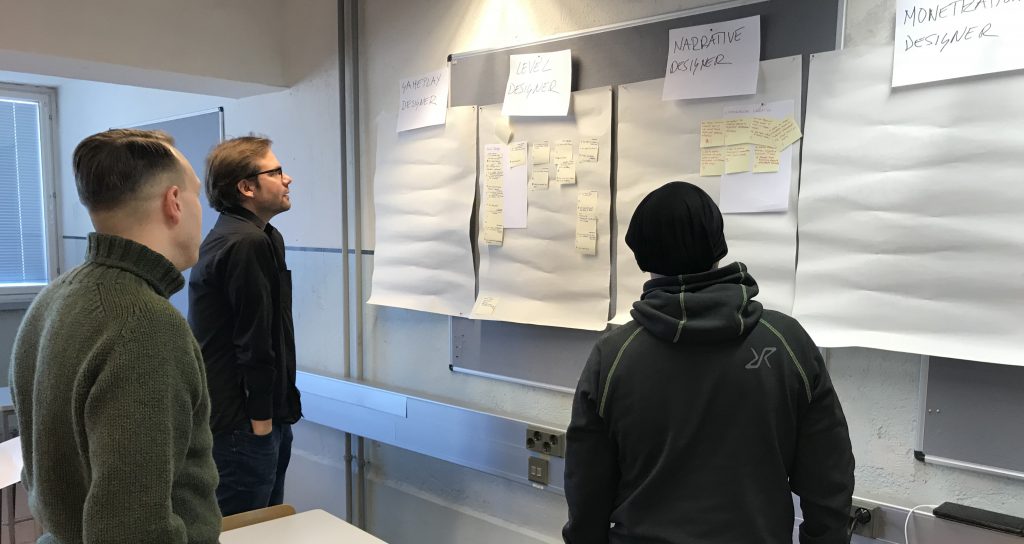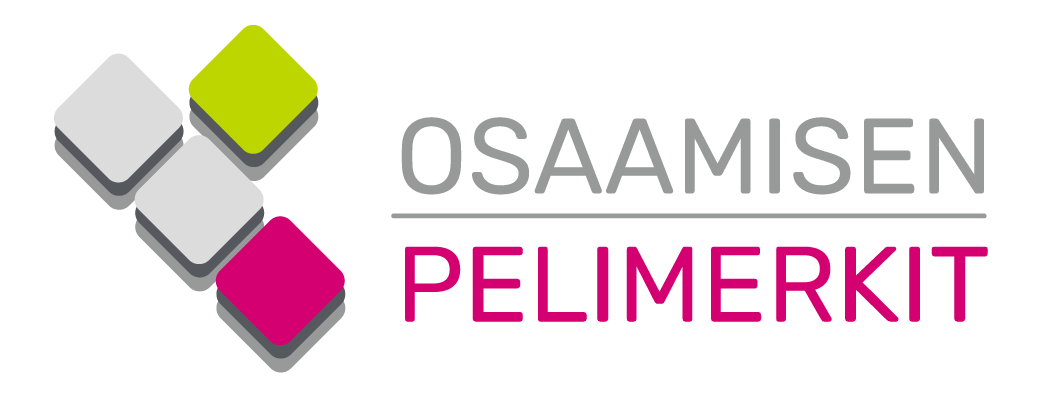Lue tämä suomeksi
The main goal of this project was to survey the competence of game industry employees, and to then convert said competence into digital open badges. The original intention was to make visible the competences of game industry students for use in contexts such as recruitment, but new and varied other benefits emerged during the study. The need for standardization within the game industry arose as an important factor as expressed by industry professionals themselves. The article investigates the working process and the thoughts and questions that emerged during it.
What is a digital open badge?
The term digital open badge (DOB) is often used to describe two different variables: competence and participation. However, we can further expand this term to cover both aspects.
Participation-based open badges (Fin. osallistumismerkki) may be granted to people who have taken part in some activity or course, if attendance is the only prerequisite for the badge; whereas competence-based open badges (Fin. osaamismerkki) are visual symbols representing competence in a certain form of work, and are excellent for validating skills acquired in non-formal and informal learning. In order to acquire a digital badge, the applicant must usually exemplify their competence in some way, such as by submitting a portfolio or other collection of works as reference. A specially appointed person assesses the material, and an accepted portfolio results in the applicant acquiring the badge. Badges can be collected in an electronic folder and sent as attachments to job applications and similar documents. The system actually resembles qualification-based degrees, but is in fact most suitable for validating briefer submissions.
Internet company Mozilla began developing the open standard badge system with a grant from the MacArthur Foundation back in 2010 (¹). However, the company has backed out of maintaining the Mozilla Backpack, which was procured by a new digital credential platform called Badgr. Other frequently utilized platforms include the Open Badge Factory by the Oulu-based company Discendum (for creating digital badges) and the Open Badge Passport (for digital badge storage).
Creating the game industry’s digital badge ecosystem

One of the primary goals and functions of the Chips for Game Skills project was to create a digital badge system specifically for the Finnish game industry. The practical planning work began in summer 2018. The first crucial issue to decide was the form of the system: deconstructing the entire game industry into individual competencies would have to be done with care. Professional titles within the industry were used as suitable reference points; the titles were distributed as follows:
- artist
- programmer
- sound designer (audio artist)
- game designer
- producer
- QA (quality assurance)
- community manager
Other delineations would certainly have been possible, but with this solution the badge families (with the profession in question and the badges related to it) all turned out to be about the same size.
It was clear from the beginning that the work would have to include a great deal of compromise. First and second-tier titles could be broken down in many different ways, and the same job description could be carried out under different terminology in different companies. There are also great differences related to the size of companies: in smaller outfits a single person could perform several overlapping tasks, while the employees of a large firm tend to have much more precisely defined tasks. Then again, these variations were the very reason the competence map was so crucial to produce.
The value of standardization came up as a subject of discussion with industry professionals on many occasions. Some of the professionals also consider the changing titles and job descriptions to be difficult. The Finnish National Agency for Education produced a report on the game industry in 2015, which found that “the games industry is a growing new sector that does not have a traditional structure or a traditional infrastructure, either hard or soft. The practices and structures in the sector are only now being created.” (²). Five years have brought many changes, but this underlying structure still doesn’t seem complete.
Writing and coordination responsibilities were distributed among the project’s implementers. The Soft Skills badges were overseen by the Laurea University of Applied Sciences, the Artist badges by the Tampere University of Applied Sciences, the Producer badges by the Oulu University of Applied Sciences, and the Programmer badges by the Metropolia University of Applied Sciences together with the Haaga-Helia University of Applied Sciences. Metropolia also coordinated the surveying of the competences for the Sound Artist and Designer badge families. Industry professionals were involved in the writing process. The badge ecosystem was constructed so that almost every achievable badge has three degrees of difficulty for different needs:
- Bronze represents basic competence (i.e. student status)
- Silver represents independent professional competence (i.e. senior status)
- Gold is reserved for the office’s greatest assets (i.e. guru status)
Divisions such as this are always problematic and partly artificial, as anyone who has assessed vocational and specialist degrees knows full well. However, adding just one more difficulty degree would have increased the number of total digital badges by almost one hundred; neither do I consider the problem of division to be fixable simply by adding a category.
By the end of the project, we were able to develop the badge system far enough to have published a competence map complete with the competence goals associated with the bronze and silver degrees. The whole process was slower and more arduous than we anticipated, so the descriptions for the gold degreel were not yet included; neither was there enough time to publish the completed competence-based badges. Hopefully this means a follow-up project can be produced in the forthcoming 2021-2027 programming period. Regardless, I would accept the use of the competence map within the game industry and in teaching, for instance as part of job ads or course planning. Individuals interested in joining the industry can also plan out their own learning paths with the help of the map. The competence map is published in Kumu.
From degree to competence

Creating distinctions and competence descriptors based in real working life was instrumental from the beginning, which is why we made use of the expertise of professionals working in the industry in question. Teachers have written and/or commented on the basic level competence descriptions especially.
We were careful not to use actual game education contents or course structures in the descriptions of the competence targets. This would have given the impression that what is already happening in education is sufficient for the needs of the whole industry. The courses themselves are constructed so differently in various institutions that we made sure to put competence and working life needs at the center of our project. Tampere University’s continuous learning director Heli Harrikari said of this topic at an event organized by science fund Sitra, that “we easily become prisoners of the systems in which we operate, and rhetoric tends to focus on courses and study points. However, the future needs of the world will be far more reliant on competence. Identifying and recognizing competence is something we must work on (³).
The same stance is repeated by education politics specialist Mari Kröger from interest group Finnish Business School Graduates, and by digital influencer Jyrki Kasvi from the Finnish Information Society Development Center (TIEKE) in his article “Näytön paikka” (⁴). They both state that continuous learning challenges the degree system, meaning that a graduate degree is impractical in demonstrating competence. “The need to study further after earning a degree has long been recognized, and the need for shorter forms of competence demonstration is constantly growing.” The article illustrates the use of digital badges as one solution to both of these needs, and finds the badges’ reliability to be pivotal in terms of usability.
I also made reliability, or more precisely credibility, the most important topic in my presentation at the ePic Conference in fall 2019 (⁵). Credibility can be measured using the following factors:
- The competence goals are relevant and comprehensive
- The requirement of competence demonstration supports the competence goals and competence may be demonstrated with said material
- The person who assesses the material is a trusted professional
- The person who grants someone a digital badge is a trusted professional
Competence or comprehension?
The first item in the above list deserves closer inspection. While creating the game industry’s competence-based digital badge ecosystem, the same problem came up again and again when defining the competence goals. In the first version the badge-earner was usually rewarded for mental competence (“the holder of this badge understands / knows X”). It is undoubtedly true that one would do well to understand what a mechanism is for and how it ties in with any given situation, in order to be able to extract something complicated out of it. Abilities could include understanding how to create dynamic music, recognizing certain processes, or being familiar with different styles and genres.
However, there is a great difficulty in verbalizing and credibly demonstrating someone’s understanding, recognition, or comprehension because it is so-called tacit internal know-how. The differences between tacit knowledge (according to Polanyi, 1966), implicit knowledge, and explicit knowledge have been addressed in numerous studies. A recent example is Ilkka Virtanen’s PhD (⁶), where he states that “in an organizational context knowing is often closely related to decision making, problem solving and reasoning in general. Knowledge that is built in such processes might be difficult to explain (…)”.
During the process of coming up with the digital open badges, we endeavored to expand on this know-how through the expression of the work itself. We approached the issue pragmatically: if a person possesses an excellent understanding of a subject, but is unaware of how to use that knowledge, it will produce no mentionable benefits for the members of the work community. The real question is, therefore, what to do with all that knowledge? At this point the work of the writers was also made clearer, when they began considering the competence goals from the point of view of productivity and production. Knowledge of dynamic music must manifest in concrete action: how does a person with knowledge act compared to someone who lacks this knowledge? What is the end goal of process identification, or why is it important to identify processes and recognize styles and genres? In the end it is a question of the final outcome, as cost-effectiveness, happier customers, better products and sales, or simply as an employee who performs their professional tasks successfully.
References:
- Mozilla (2020) OpenBadges-info (opens openbadges.org)
- Taipale-Lehto, U. & Vepsäläinen, J. (2015) Report on competences and skills needs in the games industry. Finnish National Agency for Education, Reports and studies 2015:6, 13.
- “Onni oppia, ilo osata”, Sitra event at Oodi library 17.6.2019. Programme and recording, in Finnish (opens sitra.fi)
- Kasvi, J. & Kröger, M. (2020) Näytön paikka (opens tieke.fi).
- Heinonen, S. (2019) Open Recognition and Badges in France.
- Virtanen, I. (2014) How Tacit is Tacit Knowledge? Polanyi’s theory of knowledge and its application in the knowledge management theories. Academic dissertation, 68. (opens tuni.fi).
